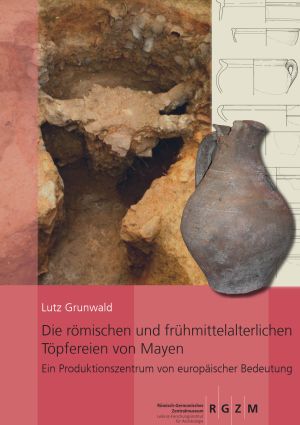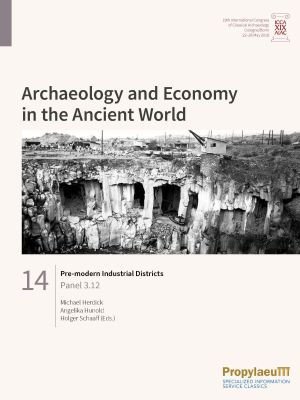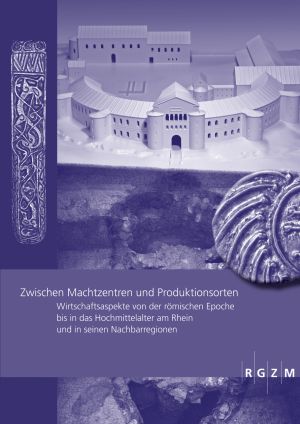Schaaff, Holger
Die römische Besiedlung im Umland der antiken Tuffbergwerke am Laacher See-Vulkan
On the Rhine, north of the Moselle, Caesar's troops found a fertile basin with farmsteads and a flourishing millstone trade. The Germanic occupation and the urbanisation policy of Emperor Augustus meant, among other things, the beginning of stone building in Germany. In particular, the tuff deposits around the Laacher See volcano became the focus of Roman builders. An ancient industrial landscape had already developed here in early Roman times, and the conditions for its development were particularly favourable - high-quality volcanic rock and the Rhine port of Andernach only 5 km away.
This book deals with more than 200 Roman settlement sites and the development of society in this part of Upper Germania over a period of some 450 years. The introduction of the tuff industry and the stationing of Roman troops quickly gave rise to a prosperous, provincial Roman mixed culture. Even after serious destruction in the 3rd century, a prosperous society developed again in the advanced 4th century until the first half of the 5th century, with increasing immigration of Germanic tribes. Outstanding finds already known, such as the Nickenich niche tomb or the Kruft column, are analysed in their overall context. Archaeological finds from the 1st to the 5th centuries, mainly from graves of the early imperial period and the first half of the 2nd century, are newly presented. More than 20 water pipes, mostly of qanat construction, as well as a presumed civil miners' settlement shed light on the characteristics of rural settlement in the area of the Roman tuff mines.
Antike Tuffbergwerke am Laacher See-Vulkan
With the tuff mines around the Laacher See volcano, we grasp the roots of the building stone industry in Central Europe. It was the master builders who came from the Mediterranean region as part of the Augustan expansion and urbanisation policy who brought the knowledge of stone architecture to our region. Quarried in extensive tunnel systems, the valuable stone was used from the beginning for the construction of representative large-scale buildings. Eloquent evidence of this is the so-called Ubier Monument in Cologne, the oldest stone building in Roman Germany. As an early export hit, tuff was the first "lightweight building stone" and a sought-after building material on ancient and medieval large-scale construction sites. Based on this 2000-year tradition, the tuff industry is still an important economic factor in the region today.
In the book, the 59 known ancient mines are described in detail, as are the techniques used to extract and process stone. The unusually good sources also allow a well-founded assessment of the yield of the deposits. Research on the numerous quarry and consecration inscriptions sheds new light on the sanctuaries in tuff mining and provides insight into the religious imagination of the people working there. A detailed study by Lutz Grunwald on the pottery from the mines led to a completely new assessment of the medieval mining activities.
Die römischen und frühmittelalterlichen Töpfereien von Mayen: Ein Produktionszentrum von europäischer Bedeutung
The Mayen ware produced in Mayen is considered characteristic and relevant to dating. These ceramic products were formative for parts of the ancient European economic structure. The Mayen potteries were part of the pre-modern industrial area between the Eastern Eifel and the Rhine. Here, a seamless transfer of knowledge and technology from the Roman era to the early Middle Ages took place throughout the 5th century. The study goes beyond the typochronological assessment of the vessel pottery. It also addresses aspects of the individual lives of the potters in their multi-layered lifeworlds, such as their beliefs, their dependencies on property or the monetary economy.
Pre-modern Industrial Districts: Panel 3.12
The ancient quarrying and mining district of the Eastern Eifel has been the subject of research by the Römisch-Germanisches Zentralmuseum (RGZM) in Mainz and Mayen since 1997. The products – primarily basalt lava millstones, tuffstone building material, and pottery – were extensively traded throughout much of Europe for many centuries.
An extensive research programme was launched to examine the wealth of evidence about the ancient stone industry in the region and its significance for the political establishment of Rome north of the Alps. The main subjects were the basalt and tuff stone industries as well as the Mayen vicus, the most important economic centre. Another subject is the pottery production, which is researched by material studies as well as by experimental archaeology. Other studies deal with the preconditions for the economic success, focussing on the infrastructure and the rural settlement conditions.
Being an industrial district of supraregional importance, the quarrying and mining district of the Eastern Eifel turned out an excellent case study for the investigation of pre-modern industrial districts in general, providing a model for the study of ancient industries: these need to be investigated with a long-term view and with a holistic approach, taking into account economic, social and settlement aspects.
Zwischen Machtzentren und Produktionsorten: Wirtschaftsaspekte von der römischen Epoche bis in das Hochmittelalter am Rhein und in seinen Nachbarregionen
On 12 November 2018, a cooperation agreement was signed in Ingelheim am Rhein between the Kaiserpfalz Research Centre based there and the Roman-Germanic Central Museum, Leibniz Research Institute for Archaeology. With this agreement, the close ties that have existed since the middle of the 19th century between the scientists in Mainz and the researchers of the Imperial Palace in Ingelheim were confirmed in writing. The future cooperation will focus particularly on European economic aspects and topics of supra-regional materials research. The first fruits of this cooperation were presented at interdisciplinary conferences on 12 and 13 November 2018 in Ingelheim and on 28 and 29 November 2019 in Mayen. These events also served as an intensive exchange with scientists from Germany and abroad. The results of both conferences are brought together in this conference volume. In 25 papers, the fundamentals of trade in the Rhineland and its neighbouring regions as well as the processes of the exchange of goods between centres of power, rural regions and production sites in the period from the Roman era to the High Middle Ages are examined from very different perspectives. Both for the large-scale development tendencies and the relationships between different economic regions as well as for the production sites and the marketing routes, the contributions offer trend-setting explanations, fundamental presentations and exceptional descriptions. They form the basis for future research in parts of Europe adjacent to the Rhineland, which is planned within the framework of the cooperation and will be reflected in further conferences.
Römische Landnutzung im antiken Industrierevier der Osteifel
From the beginning of the Roman Imperial period, the area between Mayen on the edge of the Eifel and Andernach on the Rhine experienced an enormous increase in its economic activity. In a short time, an industrial area developed there, from which wide areas in the Roman north-western provinces were supplied with high-quality basalt lava millstones, light tuff and later also heat-resistant ceramics. Quarries were newly established, land and water routes were expanded, existing outlets were extended and others were still to be developed. Setbacks in the 3rd and 4th centuries were followed by further booms.
How could the numerous workers and their families be fed, and what consequences did the success of the stone and energy-intensive pottery industries have for the environment? In order to clarify this, two Roman villas on the northern edge of the Mayen millstone quarries were investigated with geophysical measurements, excavations, geoarchaeological and botanical studies, and their entire surroundings were explored. The results are presented in this book. The inhabitants of the villa Mendig, »Im Winkel« were themselves involved in the production of millstones. In late antiquity, a surface drainage system there probably kept a transhipment point for millstones on the Segbach dry, while a fortified storage building ensured the supply of the quarrymen. Quarry owners resided in the villa Mendig, »Lungenkärchen«. It turned out to be an axial courtyard with an impressive water basin. Inspections led to the discovery of the burial ground belonging to »Lungenkärchen« with monuments made of Lorraine limestone as well as the discovery of a previously unknown vicus »Im Terl«.












